The Q&A: Carlos Guinand, the tree whisperer managing an ever-changing forest
The Road to Chelsea: Part 2. A visit to a specialist tree nursery, to meet the man responsible for growing some of the most spectacular specimens at this year’s flower shows
I am standing in a forest, but not like any I have visited before.
All around me there are trees, thousands and thousands of trees, as far as the eye can see. From saplings barely as high as my own six-foot stature, through to behemoths that would tower over any house. Rare species and unique varieties stand opposite garden favourites, combining to form an impressively diverse arboreal ecosystem. Birds dance and sing among the bare branches. Even now, in the middle of winter, it is a beautiful place to be.
Then again, I’ve never set foot in a forest where the trees have arranged themselves in such precise, evenly spaced rows. Nor, come to think of it, one where the floor isn’t a knotty tangle of trip-hazardous roots, but level ground, in large part because the trees themselves are all growing in pots…
Because this is no woodland; it is a shop. A massive shop, at that. But when you’re in the business of selling trees, you don’t do things by half.
Majestic Trees is a specialist nursery that sits between historic St Albans and somewhat less historic Luton, a little to the north of London. There are some shrubs here, and some hedging plants there, but the solid wood core of this thriving business is trees.
I have come here with my neighbour, friend and sometime colleague Alexa Ryan-Mills, who later this year will be making her Chelsea Flower Show debut with The Sadler’s Wells East Garden. Alexa has kindly invited me, and by extension you, along for the ride, to get a behind-the-scenes, Access All Areas insight into how a Chelsea show garden comes together. (In case you missed it, here’s a link to my introductory post and interview with Alexa; you can also find a quick catch-up with the designer at the bottom of this article.)
Alexa’s Chelsea garden will contain three trees – which she chose last August, as soon as she’d received confirmation of her place at the show – and she has come to Majestic today to check in on how they’re overwintering.
And our guide around the labyrinthine assortment of trees, and the subject of today’s Q&A, is nursery manager Carlos Guinand, a man with massive hands, a massive smile, and a massive – borderline obsessive – passion for trees.
Originally from Venezuela, Carlos has been in England for 15 years, and these days lives in an on-site cottage with his wife and two children. It is hard to convey just how much the man loves trees. Even a standard silver birch, ubiquitous in the UK and in his nursery alike, has him swooning from behind the wheel of one of Majestic’s fleet of all-terrain golf buggies.
I spoke to Carlos about the practicalities of managing a potted woodland, the trouble with trends, and of course, his all-time favourite trees.
This interview has been edited for length and clarity.
Can you give us a sense of the scale of your operation here at Majestic? How many trees do you have under your care at any one time?
The total land the nursery is on is 27 acres, and we have roughly between 13,000 to 14,000 trees in stock. All those trees will be in pots – we don’t grow trees straight in the fields.
Why is that?
First of all, we don’t have enough land to grow in the fields. And the second reason is because this way we are able to sell trees and deliver trees all year round. If they are in pots, we can sell them in the winter time the same as we can sell them in the summer time.
Because you don’t have to dig them up and disturb the roots in the process?
Exactly. We don’t have to wait until the dormant season before we’re able to take them out of the ground. We cannot do that during summer months, and when the trees are actively growing – it’s too stressful for them. But because here the root systems are all condensed in pots, it’s not a problem for us to deliver them and manoeuvre them during summer months.
Some of the trees are pretty sizeable and fairly well established – what impact does it have on them to spend so much time in a pot rather than letting their roots spread out as they would if they were planted in the ground?
I mean, the tree will be absolutely fine, as long as its roots find, in that small space, the moisture and the nutrients the tree requires. The tree will be absolutely happy with that. The only problem, of course, is that when we transplant them, and they are starting to establish, they don’t have the anchoring roots to stay in position, so we need to support them during their first couple of seasons in the ground.
Most of the trees here are in some interesting looking pots – probably unfamiliar to most domestic gardeners – that have lots of little holes or vents all the way around. What are these pots? And why do you prefer them to what you might call a traditional pot?
These are Air-Pots. We have over 90% of our stock in Air-Pots. There are some nurseries in certain countries, especially Italy, where they grow a lot in hard pots, and those trees are just ready to go and be planted. But if we keep those trees for longer than a season, we pot them up in Air-Pots, to try to get the root system established.
The problem that we’ve got with hard pots is the root system spiralling, because there’s nothing to stop it from growing. In an Air-Pot you don’t get that spiralling. Instead, the root will actually grow through those little holes, and when it hits the air and the light, that root will die – it’s a natural pruning that will encourage new roots to develop. And as soon as they are transplanted, they start searching immediately, growing through the new soil.
Do you do any propagation here? As in, do you grow any new trees on site? Or are all your trees sourced externally?
We don’t do any propagation, and we don’t do any grafting here. We buy them. The main supplier is Holland, without a doubt, followed by Italy, France, Germany, Belgium and Ireland. And we have some suppliers here in the UK. We only buy trees from nurseries that have very good reputations, and they’re very good growers.
I saw Alexa showing you a piece of paper with what looked like codes for her trees, like you might find in a library. How is the nursery’s stock organised?
We have sections from A-Z all around the nursery. It is not alphabetised by species – each area has different species. It has been designed so that some of those areas are for larger trees, and some of them are double rows for smaller trees. So no, it’s not by species. We would like to do that, but we have over 400 different species in stock, normally, and to organise all of them is quite complex.
I’ve heard the trees being referred to by numbers too – 10-12, 60-70, all sorts – can you please explain what those numbers are referring to?
It is the perimeter of the trunk, in centimetres, measured at one metre high. That’s the way we measure the trees, and that’s the way actually the pricing is set. So the smallest we grow here, very rarely, are 8-10s, but generally the smaller trees are more like 10-12. We have one tree here that is 110-120 – a big Wingnut, Pterocarya fraxinifolia, that alone drinks 300-500 litres of water a day.1 It is a wonderful tree, but it went wild and now we’re not able to sell it! Or rather, we can sell it, but the transport will be two, three times the price of the tree itself.
That doesn’t sound great for business. I imagine your business model is dependent on trees not hanging around indefinitely and growing into gigantic full-size specimens that are almost impossible to transport. At what stage is a decision made that a particular tree just isn’t going to be sold?
It is rare. We have had some trees that have grown too tall or too wide, but it’s very rare that we’re not able to sort out a way to deal with and transport the tree to our customer.
And are you generally looking to acquire trees that you will then sell on within that same season? Or are you playing a long game, where they’re investments, so you might be buying this one in order to sell it in 3, 5 or 10 years’ time?
No, normally, the rotation of the stock is 60-70% every year. So from what we buy this winter, 60-70% of that stock is going to be sold in the first season. Of what remains, the second year will also have quite a high number of sales. And if a tree stays too long – which I would say is any tree that stays for 5 years or more – we review the tree. We see if there is something wrong with the quality, with the shape, and ask ourselves why it’s not selling. And depending on that we do one of two things: either change the aspect of the tree and turn it into something unique or special; or reduce the price to encourage buyers.
By the sounds of it, your business model allows you to be fairly agile, in terms of stock management. Which I guess is vital, considering that different trees can become on- and off-trend from season to season, but those same trees can take years to reach a saleable size.
Yeah, that’s the trickiest part of this business, because you need to try to see in the long term what growers are going to have in stock, and how the landscape industry in general is acting, or what customers are demanding. But we base the business on the fact that there are certain species that have very reliably been our biggest commodities.
Which ones are they?
Well, Betulas [Birch] in general. Betulas are just perfect, beautiful. Carpinus [Hornbeam] as well, you need to offer. And Fagus [Beech] too. We offer all of those in a variety of shapes and sizes and species, and in very large quantities. Acers too.
We’re a small nursery, so we react to trends in a very conservative way. We won’t stock 40 of a newly on-trend tree; we’ll start with 5 and see what happens. And those 5 may stay with us for too long and we decide not to buy more. But yes, we are constantly knocking on doors and searching what is happening out there, to try to adapt as quick as possible. But that’s something that is not easy.
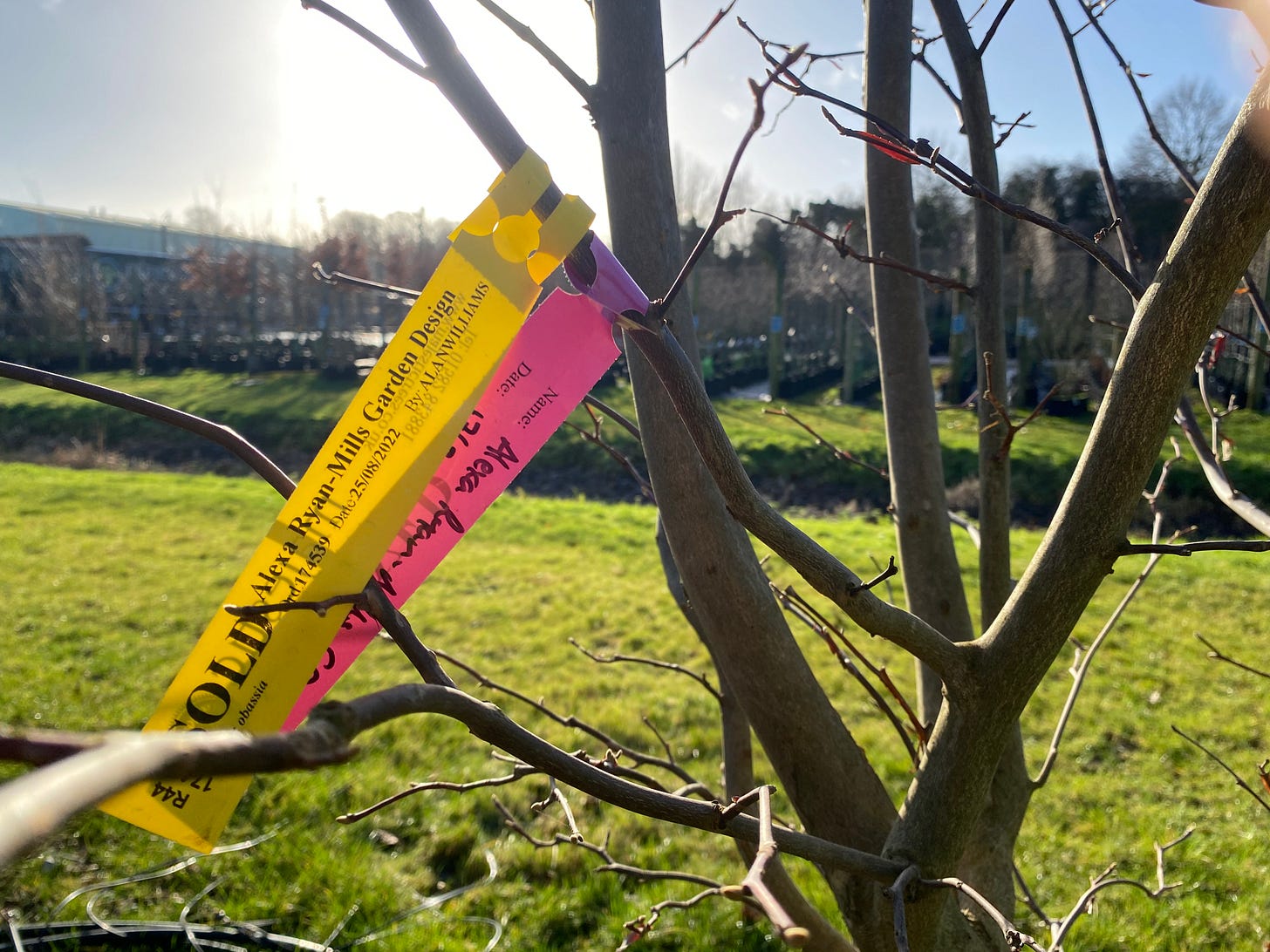
Have you spotted any tree trends that have developed over the past year or two?
It has been very stable actually for the past few years. But for example, with the death of the Queen, Quercus robur [English Oak], which is a native English tree, has been hugely in demand as a memorial tree.
And do you have any issues with Oak Processionary Moth [OPM]?2
Yes, we do. We certainly do. We don’t have the pest in the nursery, but the problem we have is that the area that the pest is in has expanded. Five years ago we were not in an area that was infested, but now we are in the buffer zone. So we can only sell Quercus within areas that are already infested, or areas within the buffer zone. And importation of Quercus has been restricted too, so we can only source oaks from areas which have been certified that they do not have OPM.
That all reduced dramatically our ability to sell Quercus. But we have been able to carry on. We are close to London, which is the biggest market for us, and of course London is completely invaded with OPM, so we have been able to carry on using that market.
You have a lot of trees here, and they’re all growing in pots. Each pot has at least one, sometimes more, irrigation outlets dripping water onto the soil, and the rows are connected with what looks like miles and miles of black piping. This must be a very water intensive operation.
It is, absolutely. The trees, if they were planted in the soil, of course would send their roots out and be looking for the water there. Here their root systems are condensed into a small area inside a pot, so they need our help. And because we have over 13,000 trees in stock, of course watering, with this irrigation system, is crucial
Every single day of summer time there is one or two people checking that the system is working properly, because we don’t want to lose trees and we don’t want to stress out trees. And working properly doesn’t just mean that it’s dripping water, but it’s also making sure the amount of water they’re getting is right. That constant updating of the system is very important.
If we get it wrong, or the system fails, in 24 hours a tree will stress. In 48 hours a tree will be dead. It’s as bad as that. Big trees, big pots, maybe not that bad, but when we have small pots, 80 litres, 50 litres, and a tree that demands a lot of water, for example Willows, it’s stressful – we need to make sure they are balanced.
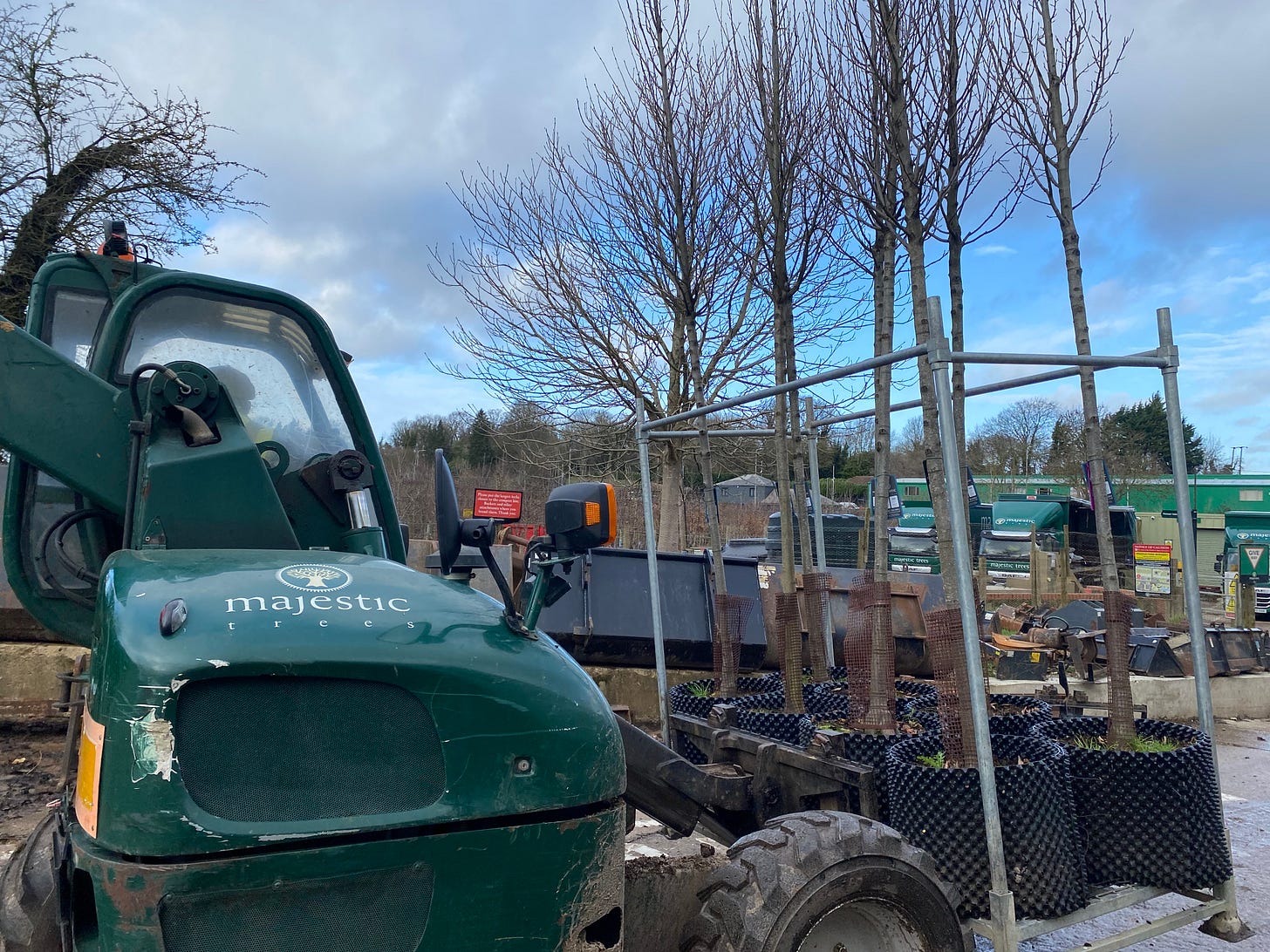
We’re constantly being bombarded with people telling us that one of the more uplifting side effects of Covid-related lockdowns was a huge upswell in the number of people interested in gardening. Is that something that you have seen play out here at Majestic? And if so, does it seem sustainable to you?
Well, lockdown I think gave people a different perspective on how they keep their own houses and their gardens. So coming out of lockdown, people were absolutely engaged with their gardens. That happened in 2020, and 2021 was a reaffirmation of that – they were our best ever years at the nursery, in terms of sales, and they were exceptional years for horticulture in general. People wanted to be there in their outdoor spaces, and to keep those spaces as their own oases. It reduced a bit in 2022, but it was still a very good year. So you can see that lockdown has triggered something in the public that is going to stay for a long time.
Maybe I’m wrong here, but it seems to me that as a tree specialist, you’re not necessarily going to get a lot of repeat custom. People have limited space, and they’re not going to go back year after year to buy more trees, in the way they might look to renew their herbaceous perennials. Long term, will we reach a point where everyone who wanted a tree now has a tree, and now no-one is buying new ones?
Yeah, we sell plants that will be [in people’s homes] forever. But we have had over the years customers who come because they have the land to plant trees. And we have quite a few customers who have manors, and extensions of land that are huge, and they are repeat-buying trees. And they might ask us for 40 trees of this species, and 20 trees of that one.
Do you have people who are looking to reforest or rewild land?
No. Rewilding from our stock would be too expensive. Our cheapest tree might be £70-£80, but if you’re buying 1,000 of them, it’s going to be crazy. So we sell more for gardens.
This is a silly question, but I feel that I have to ask: what are your personal favourite trees?
So many trees are spectacular, and they’ve got different times during the year when they show off their attributes, but my favourite is a Gleditsia triacanthos ‘Sunburst’ [Honey locust]. It is not that “wow”, but I just love it. It catches the light, and structurally the tree is so unique. It’s beautiful.
And Parrotia persica ‘Vanessa’ [Persian ironwood] – its autumn colour is astonishing. Just mind-blowing. I love it. That’s the one I’ve got in my garden actually. It was a tree that we’d sold but was damaged in transit, and so the customer rejected it. We thought it would die, but in my garden it is just growing.
You live in a cottage on site. Do you have a garden of your own there? Or is the nursery your garden?
Yes I do have a garden, but I have two children, and one of them plays football, so I have to keep it simple. But we have two flowerbeds – actually my wife and I work a lot on them. And we have one Gingko biloba, a miniature one, that is my wife’s favourite tree. And the other one that we have is one multi-stem Betula utilis ‘Jacquemontii’ [Himalayan Birch] with a Cercis canadensis 'Forest Pansy' [Eastern redbud] under it. In summertime, the contrast of the bark and the colour of the Cercis is absolutely superb. And the shape of the leaves as well, it’s just lovely.
So you have a number of trees in your garden?
Yeah we have a few. Another one I love is a Stewartia, because the colour of the bark, which is like bronze, reminds me of a tropical tree that grows in Venezuela that is called by the indigenous people there “Indio Desnudo”, which means “native person naked”. So Stewartia is another tree that I love. It’s lovely.
Even now, in January, there is something beautiful about the shapes and the forms of all these bare-branched trees. What is it like being here in spring going into summer?
Well, spring is such a spectacular season, because everything just comes to life. Though even now there is a lot happening. For example, the birds at this time of year are wonderful. The red robins, just beautiful. Because they are a part of what you’re doing – they are next to you all the time, because as soon as you're moving a tree, they know there will be some bugs or some worms that you will be exposing for them, so they are your friends.
But yes, there are a couple of weeks in springtime when everything just – boom! – explodes into life. That is spectacular. Absolutely spectacular.
It was a real privilege to spend time in the company of someone so knowledgeable and clearly passionate about horticulture (and a whole lot of fun to zip about the nursery in a golf buggy!). But of course, my visit to Majestic was also intended as an opportunity to catch up with Alexa, whose name graces tags on three rather unusual trees growing here today: a Chionanthus retusus, a Styrax obassia, and an Acer monspessulanum.
What were you hoping to see on today’s visit, Alexa?
The trees that I’ve chosen are all deciduous, so I’m looking at their form. The interesting thing about Chelsea is that because it is quite early in the season, certain trees are not guaranteed to be in leaf. That’s a very stressful thing: if you’re a designer and you’ve picked a tree that might not be in leaf. It’s an absolute nightmare. So don’t choose trees that could do that! And that’s why there are certain plants and trees at Chelsea that you see again and again, because the show is so early in the season that your choice is quite limited.
And so what was it like for you, seeing your trees, real things that are going to be in the garden, rather than just sketches or digital images?
It’s beautiful to see them, and you can really feel that they’re going to have a big impact on the garden. And they’re not the usual Birch – I wanted species that would stand an urban environment, but also be unusual. So I didn’t want a Betula. Visitors at Chelsea are going around seeing lots of different things and it can be a bit overwhelming, but if you see something you’ve not seen before you stop and want to learn more about the garden, and want to learn more about Sadler’s Wells hopefully as well. And I think the trees will grab people and stop them in their tracks.
Other than wanting to stand out from the crowd, why did you select these three trees?
All the plants in the garden have been chosen because they’ve got associations for me with dance. So it might be their shape, or that they have panicles of flowers that look like they’re spinning.
How important are the trees to your design?
I think because the category that my garden sits within is called All About Plants, having the right trees is really important. They are the main feature of the garden, because the space is supposed to be something like 75% planted. So it’s not all about what great structure I can build – the trees are the structure.
Stay tuned for the next instalment of Alexa Ryan-Mills x The Earthworm, on the road to Chelsea!
Keeping the thousands of in-stock trees suitably hydrated is massively water intensive, but surprisingly sustainable. The nursery is almost entirely self-sufficient in water. Rainwater is harvested and filtered down into two enormous reservoirs on site, and then pumped back around the nursery as required.
Oak Processionary Moth has become a huge threat for the health of the UK’s oak trees. It is not the moths themselves, but the caterpillars, that are the source of the problem. Not just because they can defoliate trees, but more worrying for authorities is the fact that the caterpillar hairs can irritate human lungs and cause breathing difficulties. The moths’ spread around the South of England is being carefully monitored and, where possible, curtailed.





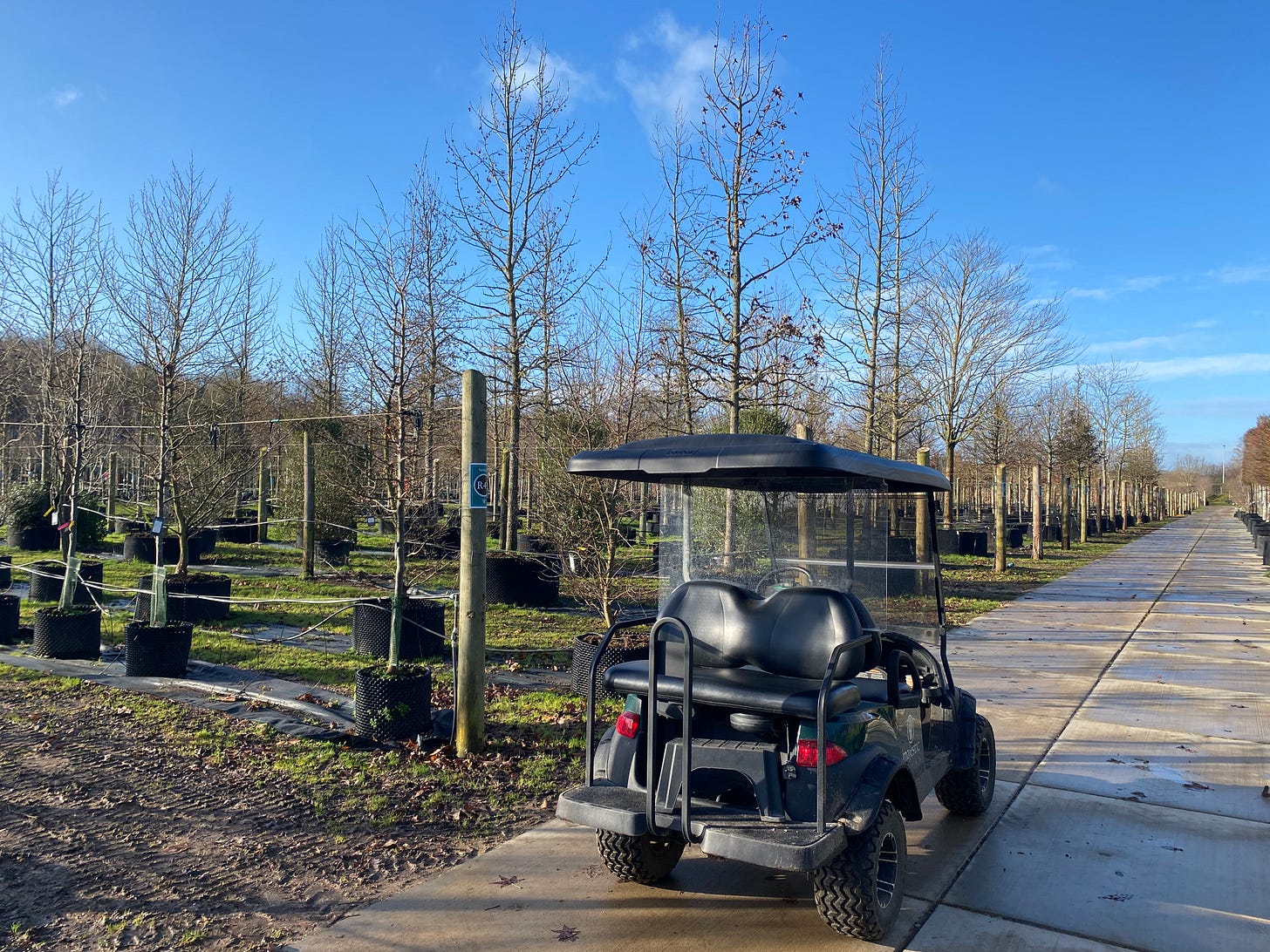
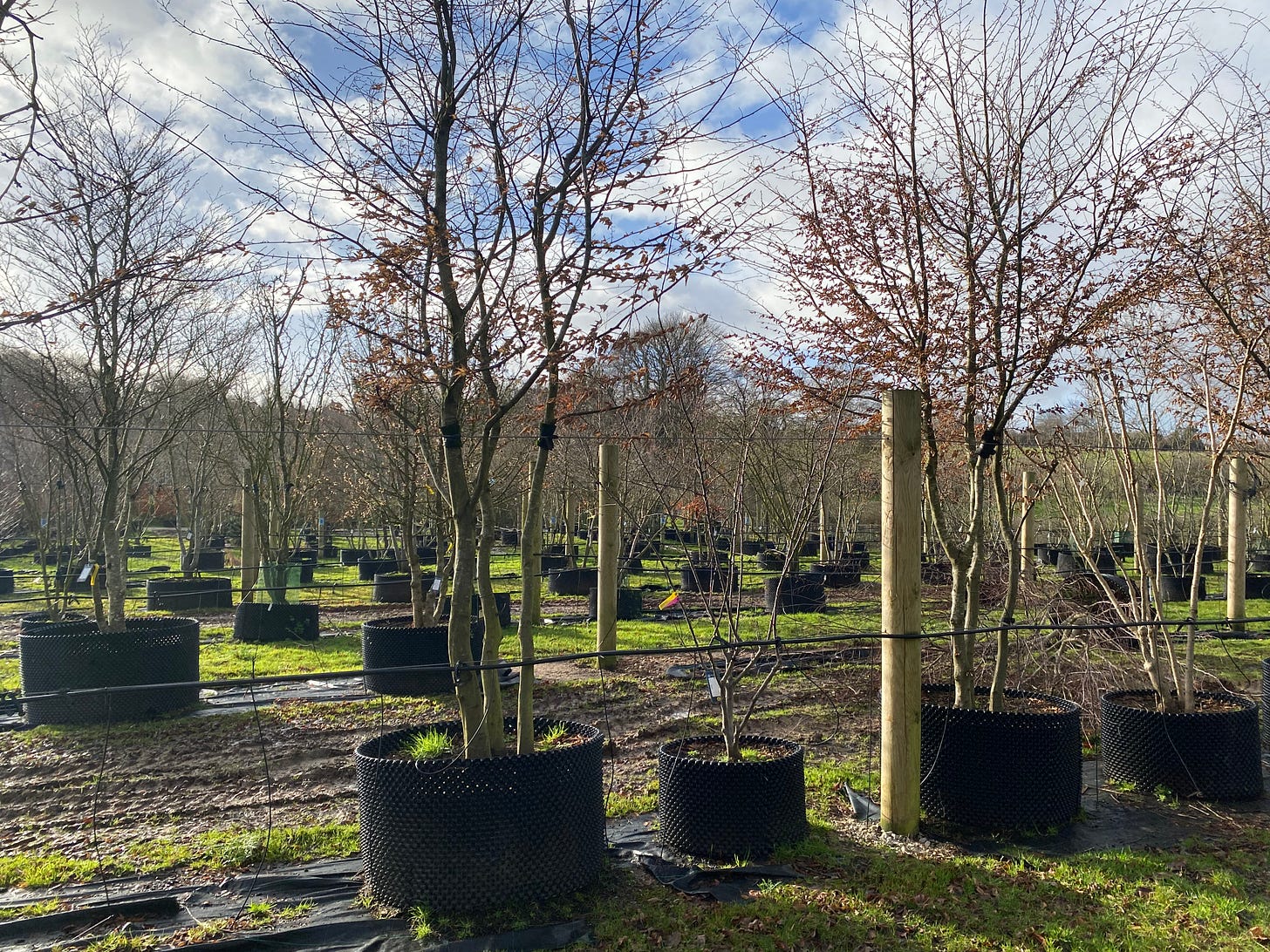
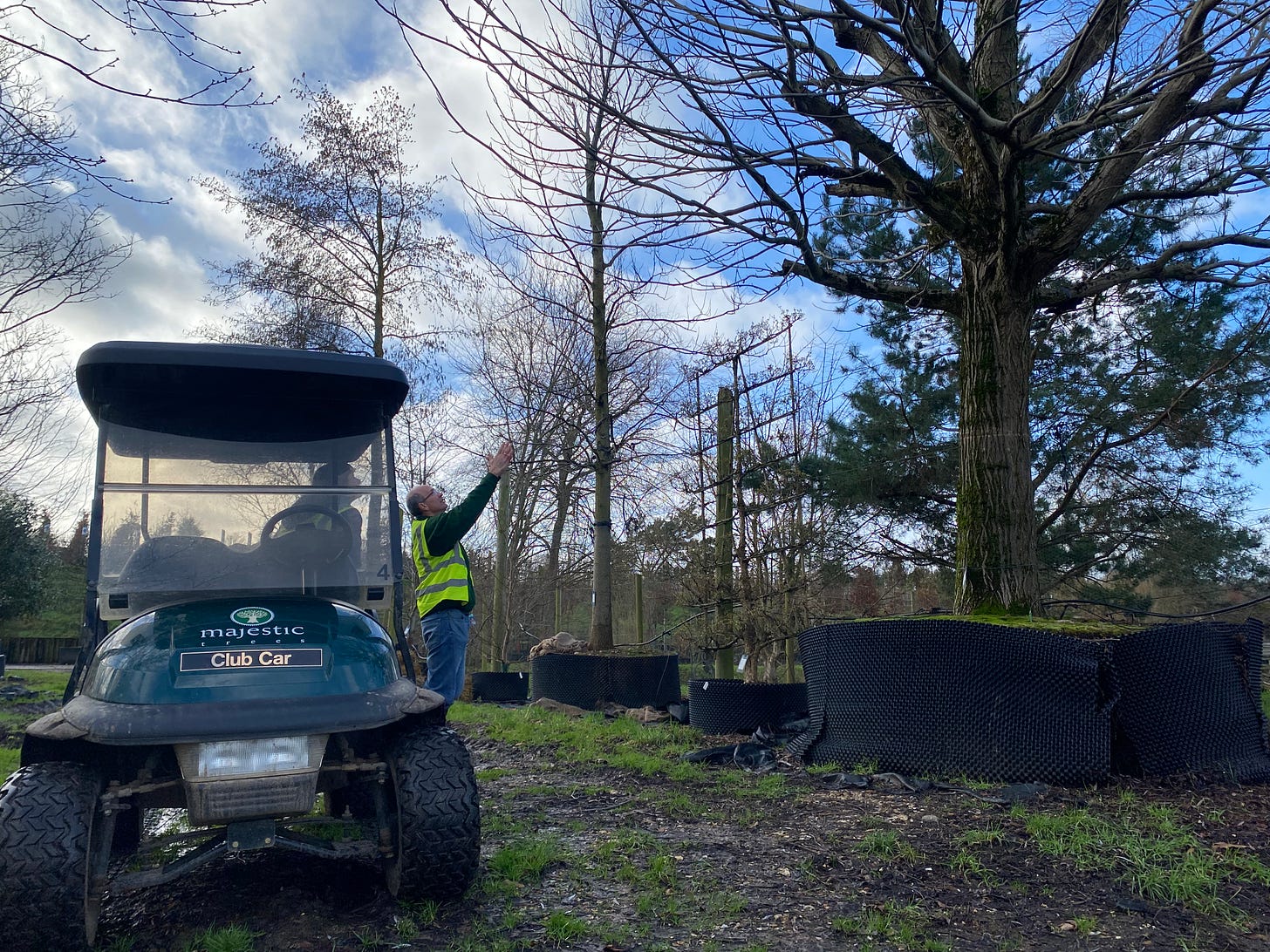

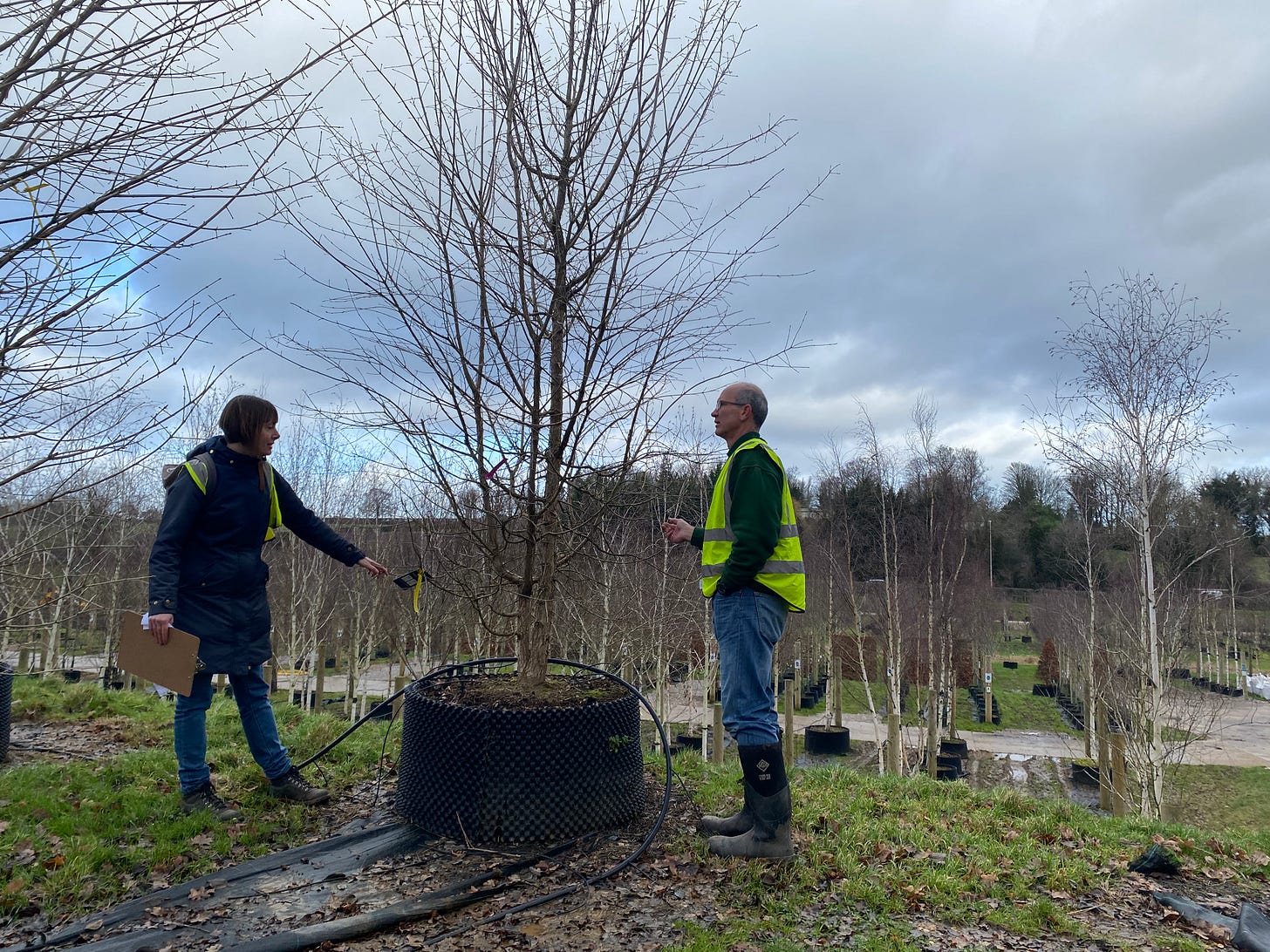
I love this series! Thanks for another great installment!
Soooo interesting!
I’ve got three trees growing on my balcony, an oak, birch and maple. I can’t wait to plant them one day out in the wild